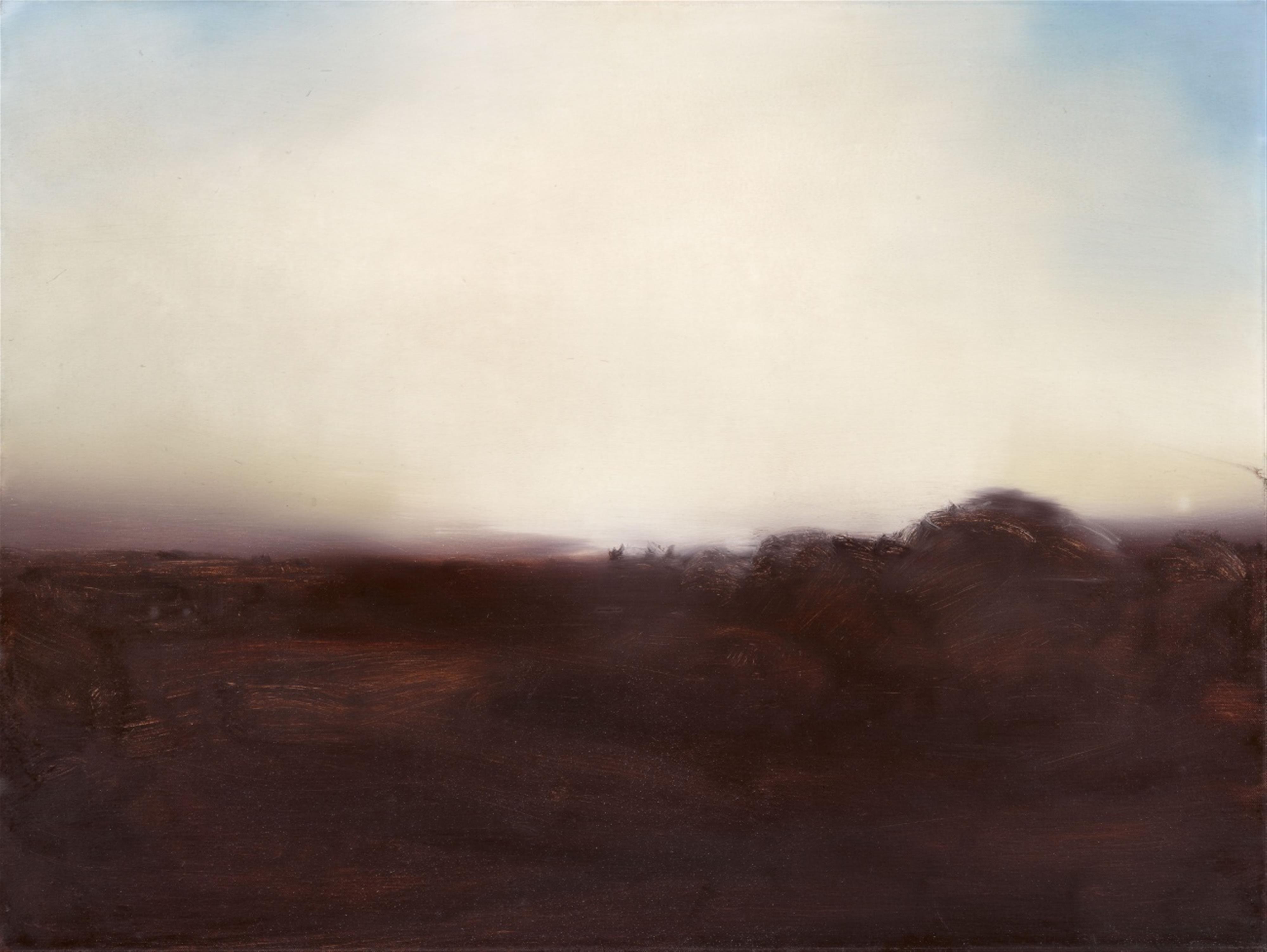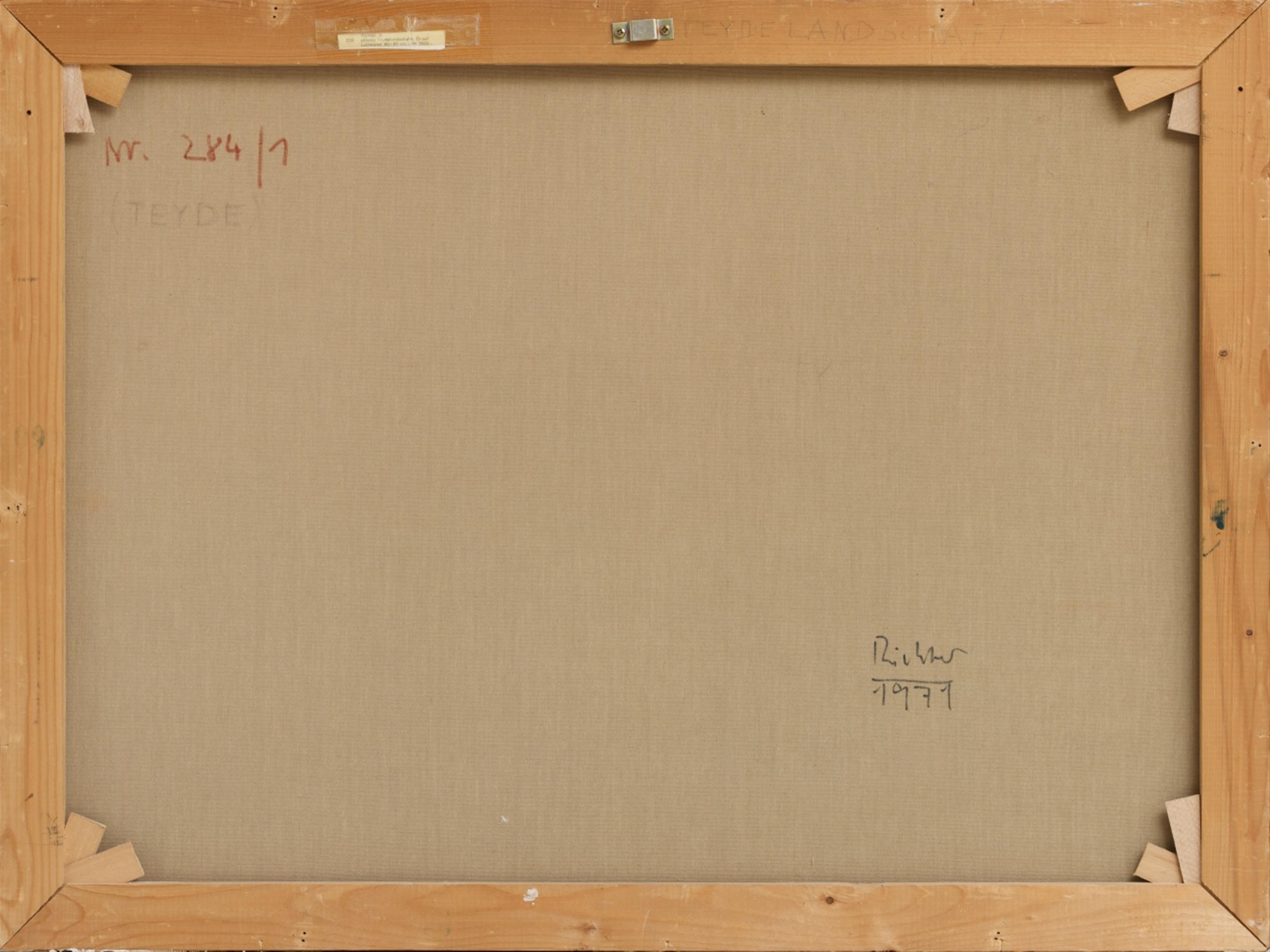Gerhard Richter
Teyde-Landschaft (sketch)
1971
Oil on canvas. 60 x 80 cm. Framed. Signed, dated, and titled 'Richter 1971 (TEYDE)' verso on canvas and with work number 'Nr. 284/1'. Additionally titled 'TEYDE LANDSCHAFT' on stretcher. - Minor traces of age.
The observer is seduced by Gerhard Richter's specifically sculptural discourse, implementing a photographically conveyed reality in his painting. Despite the photograph sometimes appearing banal, or even uninspired and unmotivated to us, Richter transforms the template into an atmospheric, mysterious motif. Through his artistic intervention, he gains our attention by elevating an insignificant detail to an object worthy to be painted and at the same time allowing a distinct, or at least surmised glimpse of the photographic template as a medial starting point.
Since 1962, Richter has been collecting photographs from books, magazines, newspaper clippings, personal souvenir photos, family photos, photo experiments or sketches and bundling them to make up an encyclopaedia of patterns, mounted and collaged on card. The so-called 'Atlas' helps to comprehend the occupation and selection process, and not least, a glimpse at Richter's panels allows us to review the transformation of the original into a painting. Moreover, one will find that the painted images can conceal details of the original from us but simultaneously allow us to comprehend Richter's radical interference and alteration intrinsic to the painting.
Representational photo-paintings, mostly in grey-white Grisaille technique, adapted from landscapes, cityscapes, mountain ranges, seascapes, portraits, figure paintings, still life, silhouettes alternating with monochrome fields of colour, all these form Richter's cosmos of images of the early years in the West.
In an interview in 1993, Richter comments on the significance of photography in his works. 'Because I was surprised by the photograph that we all use in such vast quantities every day.' says Gerhard Richter. 'All of a sudden, I perceived it differently, as a picture that conveyed to me a different view from the one I previously connected with art, bereft of any conventional criteria. It had no style, no composition, no opinion; it relieved me of any personal experience, first of all it had nothing, was simply a picture. That is why I wanted to have it - not to use it as a means of pure painting but to use the painting as a means for the photograph.' (David Britt (ed), Gerhard Richter Texte 1962 - 1993, Frankfurt/Leipzig 1993, p.67). Thus, Richter has also documented his travels to Corsica, to Vierwaldstätter Lake or to the Eifel, south of Cologne and has also recorded motifs with his camera of the barren 'Teyde Landschaft' (Teyde landscape) surrounding the volcanic mount 'Pico del Teide' on Tenerife in 1969 and has used them on various occasions in his paintings during 1971/72.
Richter favours a distant observer's standpoint with a view across a vast landscape up to a low horizon. The foreground is not emphasized here; no detail can be identified in the brownish, shimmering surface of the earth. The observer surmises the hilly landscape rather than actually recognising anything specific, the harshness of the island landscape, for example. Richter paints the transitions between the few, staged tones of colour extremely delicately. This prevents the observer from seeing the motivic details. In the effort to permeate this photographic illusionism, he reaches a limit of perception with which the motif presents itself again as painting. This manipulative interference aims to irritate the eye and Richter increases this at times by additionally combining and collaging different shots.
This approach is deeply romantic and is implemented by Caspar David Friedrich in particular as a basis for the invention of his pictorial motifs. Thus, Gerhard Richter is rightly alleged to relate to historical romanticism. Born and brought up in the baroque town of Dresden, Richter began his studies prior to migrating to the West in 1961 to continue his studies at the academy in Düsseldorf in the class of K.O. Götz. Dresden is also the city of romanticists: Caspar David Friedrich, Carl Gustav Carus and the young Dane Johan Christian Clausen Dahl are omnipresent. Their paintings hang in the New Masters Gallery, virtually next to the Dresden Academy of Fine Arts on the Brühl Terrace.
Since the centenary exhibition of 1906 at the National Gallery in Berlin with the epochal exhibition organised by Hugo von Tschudi and Julius Meier-Graefe, it is rather the calculated outlook on the early 19th century that is acknowledged and less the art of contemporary Impressionism. Artists such as Casper David Friedrich, Phillip Otto Runge, Carl Blechen, and the other romanticists pertain to the 'rediscovered'. The painting of Romanticism was elevated to a national event in Berlin and erstwhile in Dresden. To consider Gerhard Richter, who began his studies in 1952 at the academy, which was destroyed in the war and then re-built, as a successor of the romantic tradition is not so far-fetched and is the view that has always been propagated. Just as Richter examines photographic examples, he also examines the compositional examples of earlier generations of painters and combines their achievements as painters with his own aesthetic imagery: 'Seestücke' might have been created in remembrance of Gustav Courbet's series 'La Vague', 'Wolkenbilder' are reminiscent of Carus' cloud studies in the small-scale sketches, 'Teyde-Landschaften' can be compared to Friedrich's construed landscapes, in the assumption of one of the Romanticist's most important topoi, the singularized individual in nature such as the two comparatively minute figures on the left-hand side of 'Große Teyde-Landschaft mit zwei Figuren' from 1971, for example (see comparative illus.).
The landscapes by Gerhard Richter from this period imitate a scheme that C. D. Friedrich occasionally uses in his landscapes: a low horizon, a high, almost cloudless sky, and an unaccented foreground. In a letter to Jean Christoph Ammann in 1973, Richter writes: 'A picture by Caspar David Friedrich is not over, only some circumstances that created it are over, certain ideologies, for example; furthermore, if it is “good”, then it concerns us, super- ideologically, as art that we defend with quite some effort (perceiving, exhibiting, doing). Thus one can paint like Caspar David Friedrich “today”.' (ibidem: Gerhard Richter Texte, p.74.)
However, Richter always makes use of an illusionary performance, withdrawing the materiality in the revised version of the photo model and relativizing its presence with the painterly gesture of blurredness. His style of inpainting, shifting, distortion of contours helps him to counteract the recognition of the motif.
Richter's landscape painting is also romantic not only because he obviously uses formal and motivic parallels in his landscapes but because he repeatedly places the landscape motif in the focus of his creative work as a source. However, Richter does not paint landscapes then either but only ever photographs of landscapes.
Catalogue Raisonné
Elger 284-1
Provenance
From the beginning of the 1970s in German private collection; Lempertz auction 830, Dec. 2002; private collection, North Rhine-Westphalia
Literature
Venice 1972 (36. Biennale di Venezia), Gerhard Richter, Essen 1972, cat.no.284/1, p.71 with illus.
Exhibitions
Dusseldorf 1986 (Städtische Kunsthalle), Berlin (Nationalgalerie), Bern (Kunsthalle) and Vienna (Museum moderner Kunst), Gerhard Richter Bilder Paintings 1962-1985, exhib.cat., p.128 with illus.
Düsseldorf 1971 (Kunstverein für die Rheinlande und Westfalen), Gerhard Richter, Arbeiten 1962-1971, exhib.cat.no.284/1




